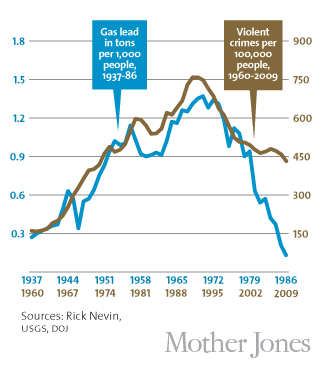The Negative Effects of Lead
There have been several studies over the last years which investigate the correlation between lead exposure and crime. Just last week, Feigenbaum and Muller (2015) [PDF] published another, looking at the correlation between the use of lead pipes in US cities in the 1890s and the homicide rates 30 years later. Their most conservative estimates "suggest that cities' use of lead service pipes increased city-level homicide rates by twenty-five percent.".
There have been more studies, and the Mother Jones article from 2013 did a good job of summarizing many of them: Rick Kevin shows in his (1999) [PDF] paper the effect of lead from gasoline in US cities on the violent crime rate 20 to 25 years later. The correlation is consistent over up to 120 years in some of his data. In another paper from (2007) [PDF], he found similar correlation in other nations, including Britain, Canada, France, Australia, Finland, Italy, West Germany, and New Zealand. Similar studies were made by Reyes (2007), and Mielkea, Zahran (2012).
What makes these studies interesting, as the Mother Jones article points out, is that they are the only theories which can accurately describe the raise and fall of the "crime epidemic" of the 1970s and 80s in the US and elsewhere. In particular, it makes the claim that the "tough on crime" and "war on drugs" had a significant effect on crime levels less likely, or at least had a minor effect compared to lead exposure.
This is important, since the government wars on abstracts and concepts, "crime" "drugs" and "terrorism" are all raging and threatening innocent lives across the US. If some of the fuel behind these polices can be removed by research, all the better.
